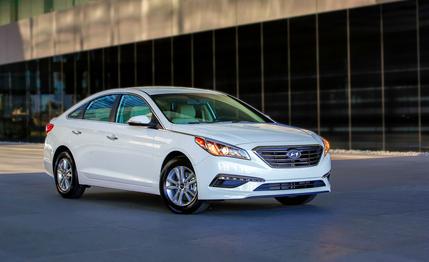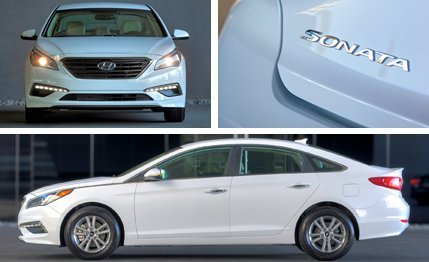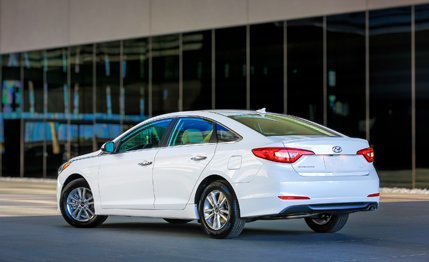 First Drive Review
First Drive Review
Fuel economy is more important than ever in the mid-size family-sedan segment. Every automaker is chasing those elusive extra mpg in every model—and not just with hybrids. Witness this new Eco edition of the 2015 Hyundai Sonata. A hybridized version of the new car will arrive next year—the outgoing Sonata hybrid will be sold until then—but the Eco is intended to give those looking for efficiency a less complicated option at a slightly lower point of entry.
The Eco gets a 1.6-liter turbocharged four-cylinder in place of the standard Sonata’s naturally aspirated 2.4-liter four, and it places a seven-speed dual-clutch automatic gearbox where the regular car has a six-speed torque-converter auto. Compared with the 2.4-liter Sonata, the Eco is estimated to return as many as 4 more mpg in the city and 3 more mpg on the highway, for totals of 28/38.

EcoNata
Although similar to the six-speed dual-clutch auto Hyundai offers in the non-turbo Veloster, the new DCT—Hyundai’s first seven-speeder of this type—has electronically actuated gearchanging rather than the Veloster’s hydraulic actuation. This change alone makes a huge difference in the Sonata Eco’s drivability. The dual-clutch Veloster tries its hardest to impersonate a regular automatic—to poor effect—but the Sonata’s DCT embraces its identity and operates more like the dual-clutch autos from Volkswagen. Even though this transmission’s brain isn’t particularly speedy at responding to swift boots of the throttle, once the gearchanges are initiated, they’re crisp and quick.
The transmission’s behavior from a stop is particularly well tuned, with little to no clutch chatter and quick takeup for immediate acceleration. Shifts handled in automatic mode are firm and prompt, and if the driver decides to call up ratios manually, he’ll be rewarded with far quicker gear swaps than are possible with the Sonata’s regular automatic. Better still, the turbocharged, direct-injected 1.6-liter four flexes its additional 18 lb-ft of torque and revs more freely than does the base 2.4-liter four. (The Eco has eight fewer horsepower.) This car shares its suspension tuning with the fine-driving 2.4, as well, which means it carries little to no handling penalty as a result of its eco-fication.

Economical Position
Starting at $24,085, the Eco occupies a nice place in the Sonata pricing hierarchy. The base 2.4-liter SE model starts at $21,960, but the Eco boasts a decent EPA fuel-economy bump and a ton of extra content, including automatic headlights, a 10-way power driver’s seat, the 5.0-inch center-stack display with Blue Link telematics capability, and a backup camera. A similarly equipped SE costs $925 less. That price differential is similar to Ford’s $795 upcharge for the 1.5-liter EcoBoost engine in the Fusion versus the base naturally aspirated 2.5-liter.
Buyers can fit their Sonata Ecos with the $4100 Technology package, which brings chrome exterior trim, a blind-spot-detection system with rear cross-traffic alert, lane-change assist, a proximity key with pushbutton ignition, hands-free trunk opening, leather for the seats and steering wheel, heated front seats, dual-zone automatic climate control, an 8.0-inch touch-screen infotainment system with Blue Link, and an auto-dimming rearview mirror. All in, a fully loaded Eco won’t break $29,000.
Will customers pony up for a few extra mpg? Time will tell. But we can say this: Eco buyers—however strong their ranks—will come away with a fairly satisfying Sonata.